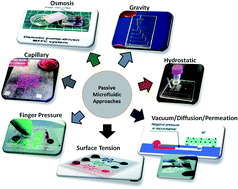Advances in passively driven microfluidics and lab-on-chip devices: a comprehensive literature review and patent analysis
Abstract
The development of passively driven microfluidic labs on chips has been increasing over the years. In the passive approach, the microfluids are usually driven and operated without any external actuators, fields, or power sources. Passive microfluidic techniques adopt osmosis, capillary action, surface tension, pressure, gravity-driven flow, hydrostatic flow, and vacuums to achieve fluid flow. There is a great need to explore labs on chips that are rapid, compact, portable, and easy to use. The evolution of these techniques is essential to meet current needs. Researchers have highlighted the vast potential in the field that needs to be explored to develop rapid passive labs on chips to suit market/researcher demands. A comprehensive review, along with patent analysis, is presented here, listing the latest advances in passive microfluidic techniques, along with the related mechanisms and applications.

- This article is part of the themed collection: 2020 Reviews in RSC Advances


 Please wait while we load your content...
Please wait while we load your content...